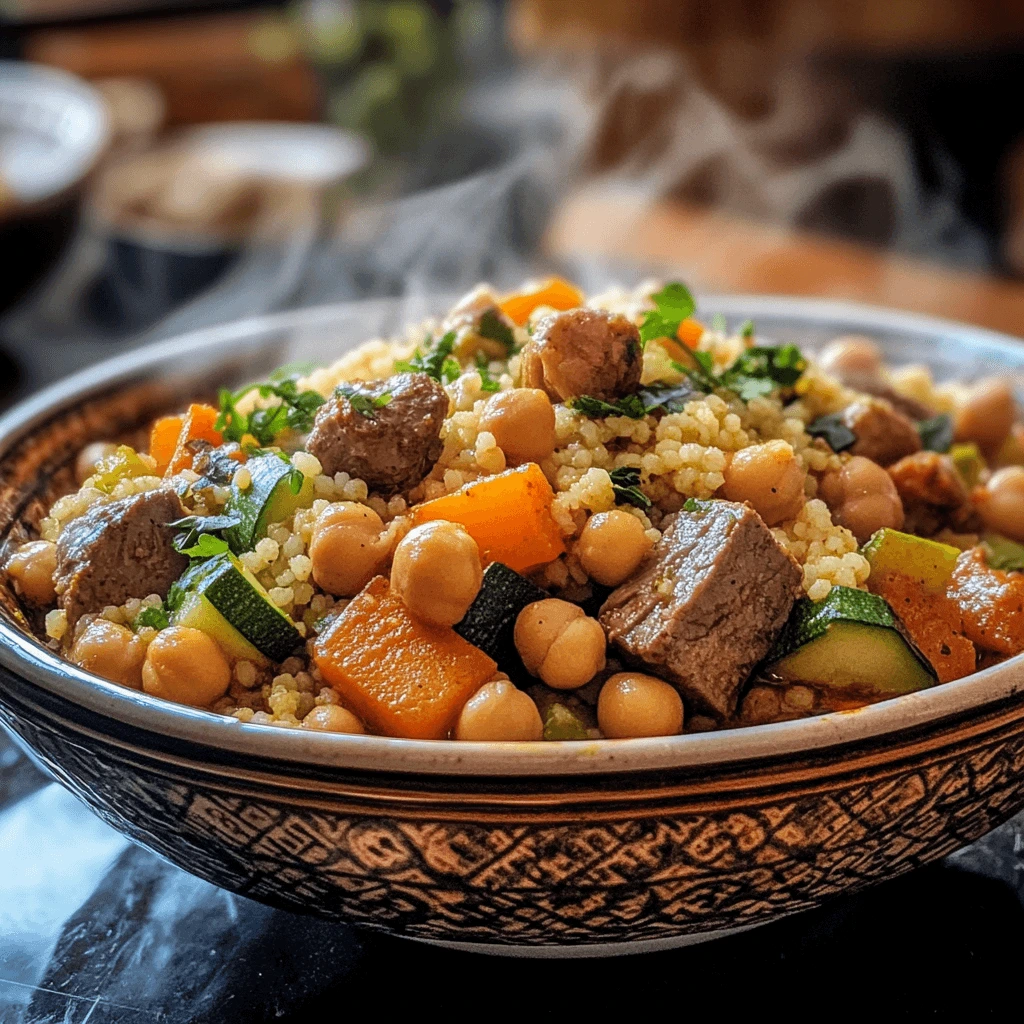Introduction
Couscous marocain, a fragrant and versatile dish, is more than just a staple of Moroccan cuisine — it’s a symbol of culture, tradition, and family gatherings. This iconic North African food has captured hearts worldwide for its rich flavors, health benefits, and adaptability. Whether you’ve tasted it at a Moroccan festival or are looking to bring authentic Moroccan flair into your kitchen, this ultimate guide will walk you through everything you need to know about couscous marocain — from its history and health benefits to easy homemade recipes and perfect pairings.
Print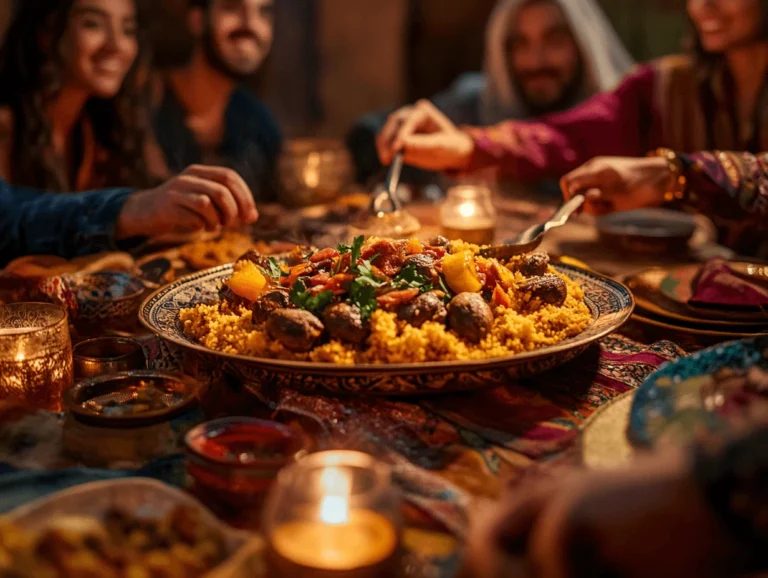
Couscous Marocain: The Ultimate Guide to Morocco’s Iconic Dish
Un plat traditionnel marocain à base de couscous de semoule fine accompagné d’un ragoût savoureux de légumes et de viande, relevé d’épices chaudes comme la cannelle et le cumin. Parfait pour les repas en famille et les occasions spéciales.
- Total Time: 1 heure
- Yield: 4 portions 1x
Ingredients
2 tasses de couscous marocain (semoule fine)
2 cuillères à soupe d’huile d’olive
1 oignon moyen, haché
3 carottes, coupées en rondelles
1 courgette, coupée en morceaux
1 tasse de pois chiches cuits
1 lb (450g) d’agneau ou poulet coupé en morceaux (optionnel)
1 cuillère à café de cumin moulu
1 cuillère à café de cannelle moulue
1/2 cuillère à café de curcuma
Sel et poivre au goût
2 tasses de bouillon de légumes ou de poulet
Coriandre fraîche pour garnir (optionnel)
Instructions
Chauffer l’huile d’olive dans une grande casserole à feu moyen. Ajouter l’oignon et faire revenir jusqu’à ce qu’il soit translucide.
Ajouter les morceaux d’agneau ou poulet et les faire dorer sur toutes les faces.
Incorporer les carottes, la courgette, les pois chiches, et les épices (cumin, cannelle, curcuma), saler et poivrer. Mélanger bien.
Verser le bouillon, porter à ébullition, puis réduire le feu et laisser mijoter à couvert pendant 30 à 40 minutes, jusqu’à ce que la viande et les légumes soient tendres.
Pendant ce temps, préparer le couscous : placer la semoule dans un grand bol, verser de l’eau bouillante (ou bouillon) juste assez pour couvrir, couvrir et laisser reposer 5 minutes.
Égrener le couscous à la fourchette, ajouter un filet d’huile d’olive et mélanger.
Servir le couscous chaud avec le ragoût par-dessus. Garnir de coriandre fraîche si désiré.
Notes
Pour une version végétarienne, omettez la viande et ajoutez plus de légumes comme le potiron ou les navets.
Le couscous peut être cuit à la vapeur pour une texture encore plus légère.
Accompagnez de harissa pour un peu de piquant.
- Prep Time: 15 minutes
- Cook Time: 45 minutes
- Category: Plat principal
- Method: Mijoté / Cuisson à la casserole
- Cuisine: Marocaine
Nutrition
- Serving Size: 1 assiette (environ 300g)
- Calories: 350 kcal (estimation par portion)
- Sugar: 5 g
- Sodium: 450 mg
- Fat: 10 g
- Saturated Fat: 3 g
- Unsaturated Fat: 6 g
- Trans Fat: 0 g
- Carbohydrates: 50 g
- Fiber: 6 g
- Protein: 15 g
- Cholesterol: 40 mg
Keywords: couscous marocain, couscous recette, couscous traditionnel, couscous légumes, plat marocain
Couscous marocain is traditionally made from semolina grains steamed to fluffy perfection, paired with vegetables, meats, or spices, creating a dish that’s both hearty and nutritious. In this article, we’ll explore authentic Moroccan couscous recipes, including vegetarian and lamb variations, and even some modern twists. We’ll also provide practical tips on cooking, buying, and storing couscous, so you can enjoy this staple anytime.
Table of Contents
Table of Contents
Understanding Couscous Marocain
What Is Couscous Marocain? Origins and History
Couscous marocain is a traditional Moroccan dish made of small steamed granules of durum wheat semolina. Dating back centuries, couscous originated in the Maghreb region of North Africa, where it quickly became a beloved staple for both everyday meals and special occasions.
Moroccan couscous is distinct from other North African versions due to its unique preparation method and accompanying ingredients. It’s often served with a rich stew of meats (commonly lamb or chicken) and a colorful medley of vegetables like carrots, zucchini, and chickpeas, all spiced with cinnamon, cumin, and turmeric.
Historically, couscous was more than just food—it represented hospitality, family unity, and celebration. Today, couscous marocain remains a centerpiece during Moroccan festivals and family gatherings.
Key Ingredients in Traditional Moroccan Couscous
Here is a table showing the core ingredients that define traditional couscous marocain:
| Ingredient | Description | Role in Dish |
|---|---|---|
| Semolina flour | Durum wheat granules | Base grain, steamed to fluffiness |
| Lamb or Chicken | Meat often used | Protein, adds rich flavor |
| Vegetables | Carrots, zucchini, chickpeas, onions | Nutrients, texture, and sweetness |
| Spices | Cumin, cinnamon, turmeric, saffron | Adds aroma and warm flavors |
| Olive oil | Used for cooking and drizzling | Enhances richness and mouthfeel |
| Harissa (optional) | Spicy chili paste | Adds heat and depth |
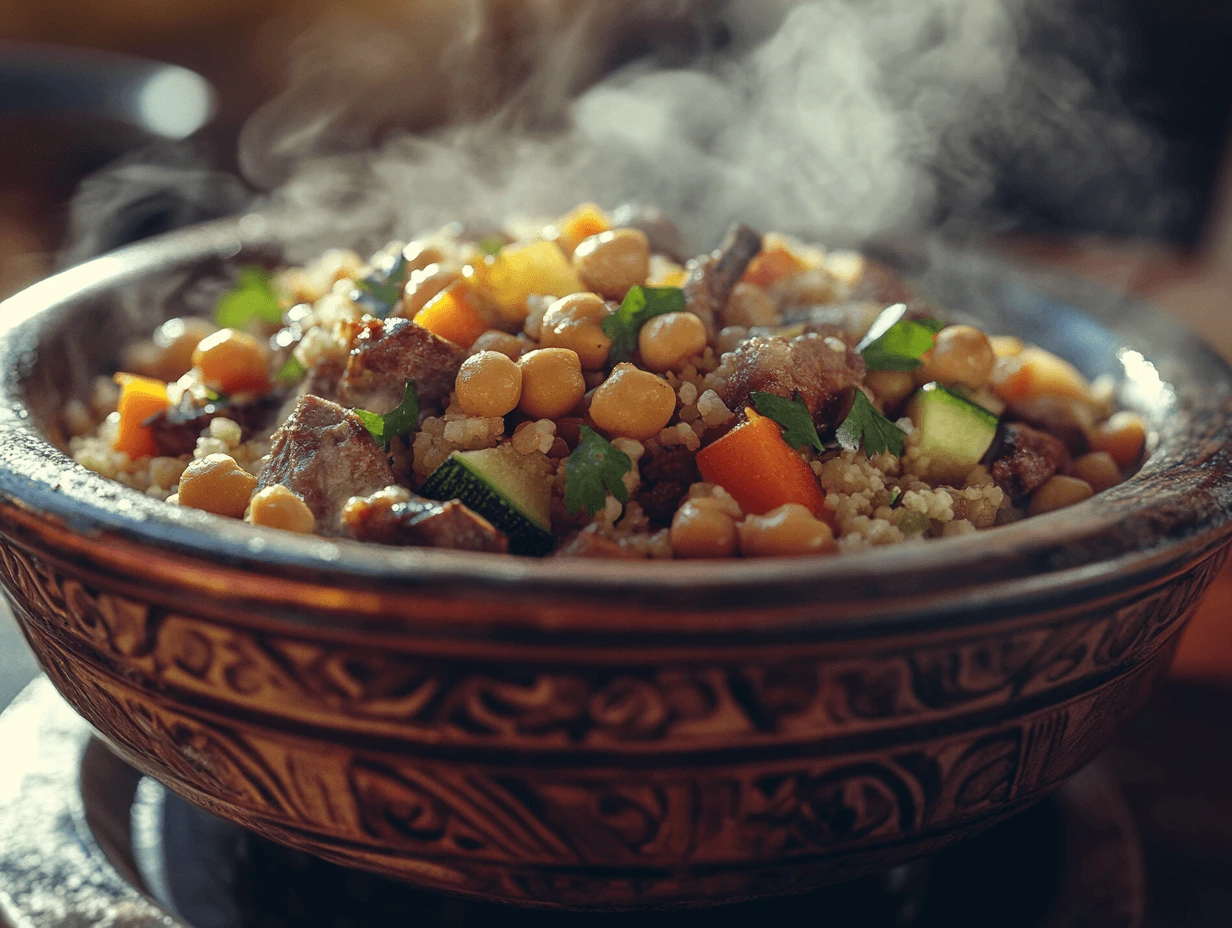
Health Benefits of Moroccan Couscous
Is Moroccan Couscous Good for You? Nutritional Breakdown
Moroccan couscous isn’t just delicious—it’s also quite nutritious. Couscous is primarily made from semolina wheat, which provides a good source of carbohydrates for energy, along with essential nutrients like protein, fiber, and minerals. Compared to many other grains, couscous is light and easy to digest, making it an excellent base for healthy meals.
Here’s a detailed nutritional table for a 1-cup (157g) serving of cooked couscous marocain:
| Nutrient | Amount per Serving | % Daily Value* |
|---|---|---|
| Calories | 176 kcal | 9% |
| Carbohydrates | 36 g | 12% |
| Protein | 6 g | 12% |
| Fat | 0.3 g | 0.5% |
| Fiber | 2.2 g | 9% |
| Iron | 1.7 mg | 9% |
| Magnesium | 24 mg | 6% |
| Selenium | 27.2 mcg | 39% |
*Percent Daily Values are based on a 2,000-calorie diet.
Because couscous is low in fat and contains a moderate amount of protein and fiber, it supports weight management and digestive health. Additionally, the selenium content in couscous is significant; selenium is a powerful antioxidant that helps protect cells from damage.
How Couscous Marocain Fits into a Balanced Diet
Incorporating couscous marocain into your meals can support a balanced diet, especially when paired with lean proteins and fresh vegetables. Traditional Moroccan couscous dishes often combine couscous with nutrient-rich ingredients like chickpeas, root vegetables, and lean lamb or chicken.
Here are some reasons couscous fits well into healthy eating plans:
- Low Fat, High Carbs: Ideal for sustained energy without heavy fats.
- Good Source of Fiber: Aids digestion and promotes gut health.
- Rich in Minerals: Supports immune function and metabolism.
- Versatile: Easily paired with vegetables, legumes, and lean meats.
For those looking for plant-based options, vegetarian Moroccan couscous dishes using lentils or chickpeas provide ample protein and fiber while keeping meals wholesome and light.
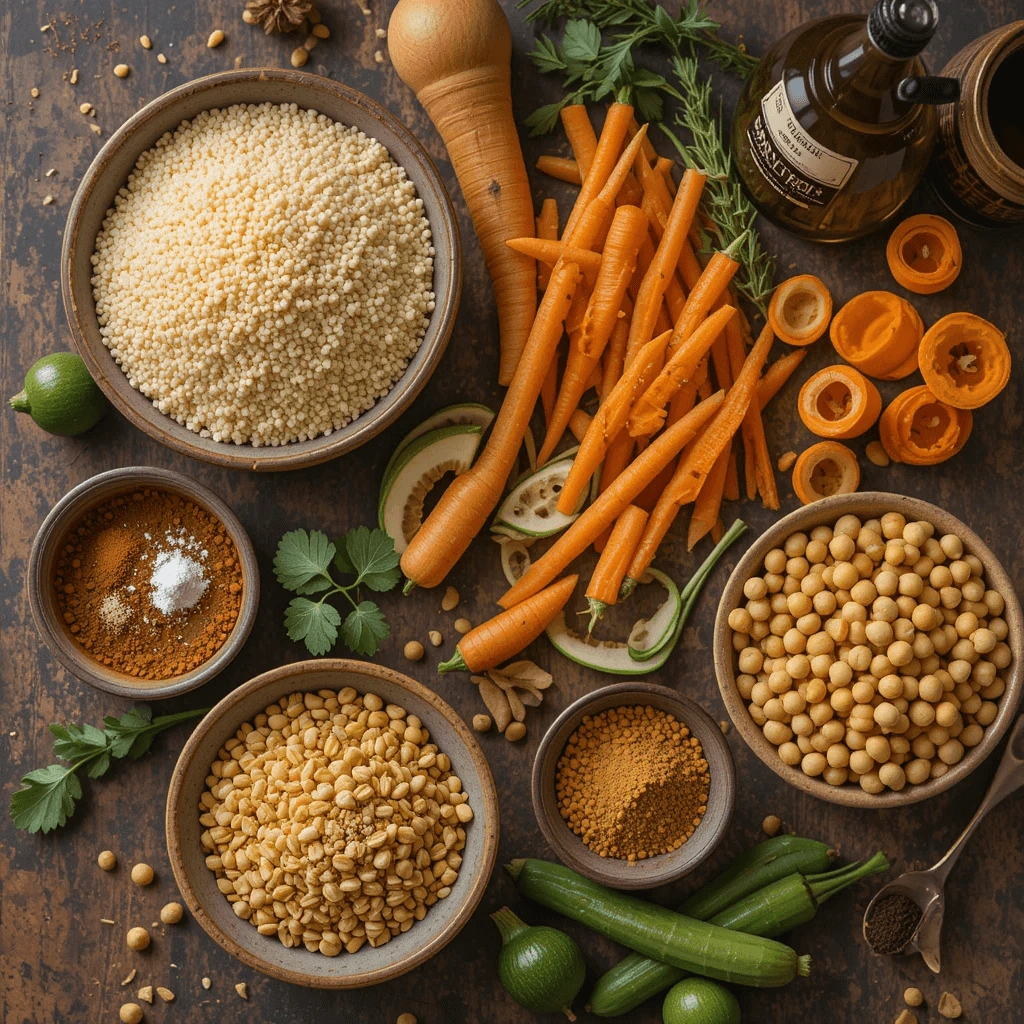
How to Make Moroccan Style Couscous at Home
Step-by-Step Moroccan Couscous Recipe
Making couscous marocain from scratch might seem intimidating, but it’s surprisingly simple once you know the steps. Below is a basic recipe that yields fluffy, flavorful couscous with a vegetable stew.
Ingredients:
- 2 cups couscous (semolina)
- 2 cups vegetable or chicken broth
- 1 onion, chopped
- 2 carrots, sliced
- 1 zucchini, chopped
- 1 cup chickpeas, cooked
- 1 tsp ground cumin
- 1 tsp ground cinnamon
- Salt and pepper to taste
- Olive oil
Instructions:
- In a large pot, heat olive oil and sauté onions until translucent.
- Add carrots, zucchini, chickpeas, cumin, cinnamon, salt, and pepper. Stir and cook for 5 minutes.
- Pour in broth and bring to a boil. Reduce heat and simmer until vegetables are tender.
- Meanwhile, place couscous in a large bowl. Pour boiling water or broth over couscous, cover tightly, and let it steam for 5 minutes.
- Fluff couscous with a fork, drizzle with olive oil, and season with salt.
- Serve vegetable stew over couscous or on the side.
This recipe is a great base. You can add meat or additional spices to suit your preferences.
Tips for Perfect Texture and Flavor
- Steam, don’t boil: Traditional Moroccan couscous is steamed multiple times to get the right texture. If you don’t have a steamer, cover the bowl tightly and let couscous absorb hot liquid for fluffiness.
- Use broth instead of water: Adds more depth to the couscous flavor.
- Fluff with a fork: Prevents clumping and keeps couscous light.
- Add olive oil or butter: Enhances richness and mouthfeel.
Want to try a classic meat-based dish? Check out our traditional lamb couscous recipe here: Traditional Lamb Couscous.
Traditional Moroccan Couscous Variations
Couscous with Lamb and Vegetables
One of the most beloved Moroccan couscous dishes features tender lamb cooked slowly with a mix of vegetables and aromatic spices. This variation is rich and hearty, perfect for special occasions.
Common Ingredients:
- Lamb shoulder or shank
- Carrots, turnips, zucchini, pumpkin
- Chickpeas
- Onions and garlic
- Spices: cumin, coriander, saffron, ginger, cinnamon
Cooking Method:
The lamb is browned and then simmered in a spiced broth along with vegetables until tender. The broth is served over fluffy couscous. This method locks in deep flavors and makes a balanced meal.
Vegetarian and Vegan Moroccan Couscous Options
Vegetarian and vegan versions have grown popular, highlighting seasonal vegetables, chickpeas, and aromatic spices without meat.
Popular vegetable choices:
- Butternut squash
- Carrots
- Tomatoes
- Eggplant
- Bell peppers
Additions like raisins or dates provide natural sweetness, while harissa paste adds a spicy kick.
Table: Comparison of Popular Couscous Variations
| Variation | Main Protein | Vegetables Used | Flavor Profile | Suitable for Diets |
|---|---|---|---|---|
| Lamb Couscous | Lamb | Carrots, zucchini, turnips | Rich, spiced, savory | Omnivores |
| Chicken Couscous | Chicken | Carrots, chickpeas, onions | Mild, aromatic | Omnivores |
| Vegetarian Couscous | Chickpeas, legumes | Butternut squash, tomatoes | Sweet, spicy | Vegetarian, Vegan |
| Seafood Couscous | Fish or shrimp | Tomatoes, peppers | Light, fresh | Pescatarian |
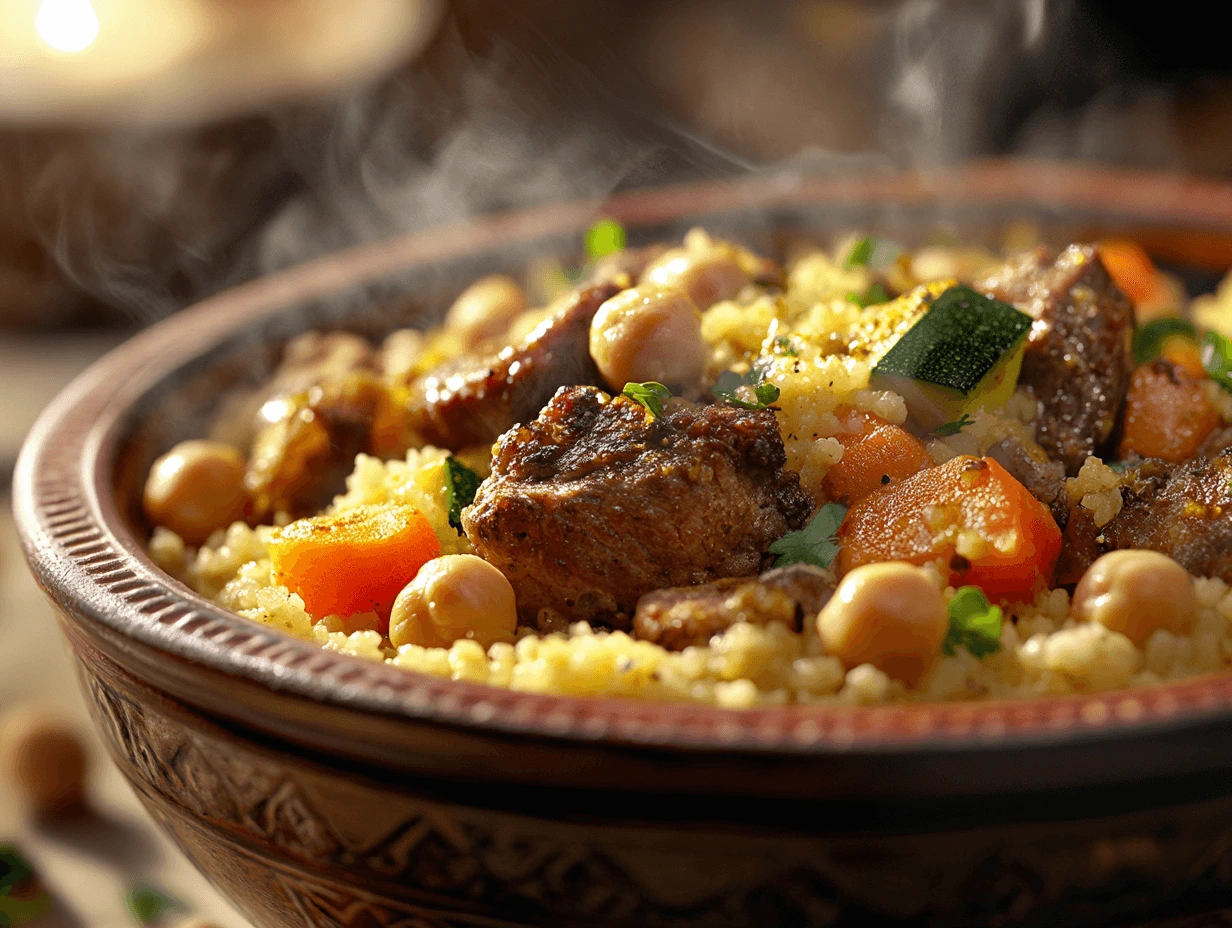
What Do You Eat with Moroccan Couscous?
Popular Side Dishes and Sauces
Moroccan couscous is typically served with several flavorful sides to complete the meal:
- Harira Soup: A tomato-based soup with lentils and chickpeas often served before couscous.
- Taktouka: A smoky tomato and roasted pepper salad.
- Zaalouk: A spiced eggplant dip.
- Harissa: Spicy chili paste used as a condiment.
Moroccan Salads and Accompaniments to Serve
Fresh salads with lemon and olive oil balance the richness of couscous dishes. Common Moroccan salads include:
- Orange and olive salad
- Tomato and cucumber salad with fresh herbs
- Carrot and cumin salad
Table: Typical Moroccan Couscous Accompaniments
| Dish | Description | Flavor Profile | When Served |
|---|---|---|---|
| Harira Soup | Hearty lentil and tomato soup | Savory, spiced | Starter |
| Taktouka | Tomato and roasted bell pepper salad | Smoky, tangy | Side dish |
| Zaalouk | Roasted eggplant dip with garlic and spices | Rich, earthy | Dip or side |
| Harissa | Spicy chili paste | Hot, spicy | Condiment |
Couscous Marocain in Moroccan Culture and Festivals
Role of Couscous in Moroccan Celebrations
In Morocco, couscous isn’t just food; it’s tradition. It’s customary to serve couscous on Fridays (a holy day) and during major family celebrations such as weddings, births, and religious holidays like Eid.
Sharing couscous symbolizes hospitality and community. Often, large couscous platters are served communally, encouraging bonding.
Regional Differences in Couscous Preparation
Different Moroccan regions add their unique spin on couscous. For example:
- Fes: Uses more spices like saffron and sometimes dried fruits.
- Rabat: Emphasizes fresh vegetables and lamb.
- Atlas Mountains: Incorporates barley couscous for a nuttier flavor.
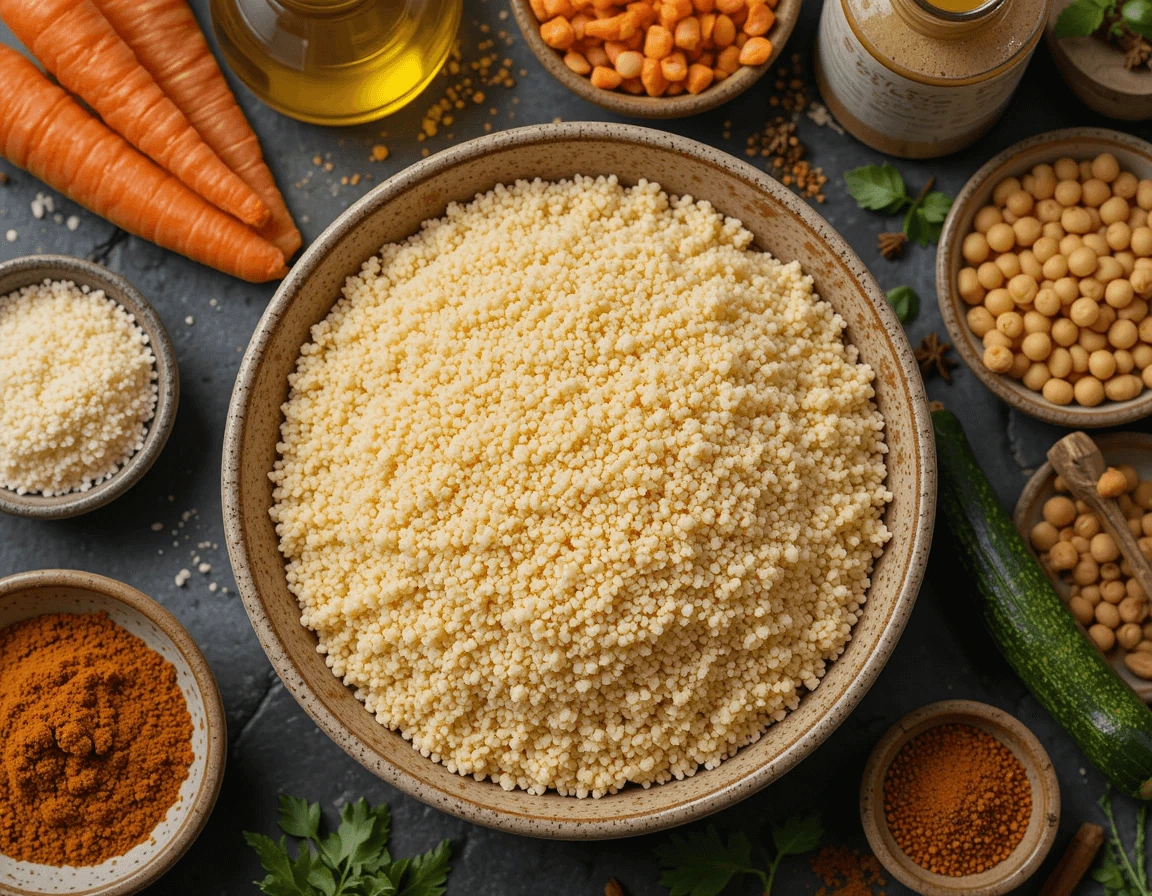
Modern Twists on Couscous Marocain
Fusion Recipes and Global Variations
While couscous marocain remains a beloved traditional dish, modern chefs and home cooks alike have embraced creativity, reinventing this classic to fit contemporary tastes and lifestyles. Today, couscous transcends its North African roots, appearing in fusion recipes that blend Moroccan flavors with global influences.
Some exciting modern twists include:
- Mediterranean Couscous Bowls: Combining couscous with ingredients like avocado, feta cheese, olives, and fresh herbs for a vibrant, healthy meal perfect for lunch or dinner.
- Couscous-Stuffed Vegetables: Bell peppers, zucchini, or tomatoes stuffed with spiced couscous and baked to perfection offer a colorful and nutritious option for vegetarians and meat-eaters alike.
- Cold Couscous Salads: Perfect for warmer months, these salads mix couscous with fresh vegetables, citrus dressings, nuts, and dried fruits, making them refreshing and light.
These variations maintain the essence of couscous marocain while adapting to new flavor profiles and dietary preferences.
Using Couscous in Contemporary Cooking
Couscous’s quick cooking time and versatility make it a favorite for busy households and creative chefs. Here’s how couscous marocain fits into modern kitchens:
- Quick Weeknight Meals: Toss cooked couscous with sautéed veggies, beans, or grilled meats for a fast, nutritious dinner.
- Meal Prep Friendly: Couscous holds up well in the fridge, making it ideal for batch cooking and packed lunches.
- Healthy Swaps: Use couscous as a lighter alternative to rice or pasta in casseroles and stir-fries.
- Global Flavor Mashups: Incorporate ingredients like soy sauce, curry spices, or fresh mango to create exciting new dishes inspired by global cuisines.
Table: Modern Couscous Marocain Variations and Key Ingredients
| Modern Variation | Key Ingredients | Serving Style | Ideal For |
|---|---|---|---|
| Mediterranean Couscous Bowl | Avocado, feta, olives, cherry tomatoes, herbs | Cold or room temperature | Quick meals, lunches |
| Stuffed Bell Peppers | Couscous, spices, vegetables, cheese (optional) | Baked | Vegetarian dinners |
| Cold Citrus Couscous Salad | Couscous, oranges, mint, almonds, dried cranberries | Chilled salad | Summer meals, picnics |
| Spiced Couscous Stir-fry | Couscous, mixed vegetables, curry powder | Hot | Fusion dishes, weeknight meals |
By experimenting with these modern takes on couscous marocain, you can enjoy the best of both worlds—the authentic Moroccan flavors and the convenience and creativity of contemporary cooking.
Looking for inspiration? Try our Mediterranean Couscous Salad for a fresh, modern take on couscous marocain: Mediterranean Couscous Salad.
Buying and Storing Couscous for Moroccan Recipes
Choosing the Right Couscous: Types and Quality
When it comes to making authentic couscous marocain, choosing the right type of couscous is essential for the perfect texture and flavor. There are several varieties available on the market, each with its own characteristics:
- Moroccan Couscous: The most common type, featuring very fine granules made from semolina wheat. It cooks quickly and creates a light, fluffy texture perfect for traditional Moroccan dishes.
- Israeli (Pearl) Couscous: Larger, pearl-shaped granules with a slightly chewy texture. It’s toasted before packaging, giving it a nutty flavor. Although not traditional for Moroccan recipes, it works well in salads and fusion dishes.
- Lebanese Couscous (Moghrabieh): Larger than Israeli couscous and with a denser texture, this type is usually toasted and used in some North African and Middle Eastern dishes.
For authentic couscous marocain recipes, the fine Moroccan couscous is your best bet. Look for high-quality brands that use 100% durum wheat semolina for the best flavor and texture.
What to Look for When Buying Couscous
- Freshness: Check the packaging date and opt for the freshest couscous to avoid stale grains that may clump.
- Ingredients: Ideally, couscous should contain only durum wheat semolina, without additives or preservatives.
- Packaging: Choose couscous that is sealed airtight to maintain freshness and avoid moisture contamination.
Storage Tips to Keep Couscous Fresh
Proper storage is crucial to preserve couscous quality and extend its shelf life:
- Airtight Containers: After opening, transfer couscous into an airtight container to protect it from air and humidity.
- Cool, Dry Place: Store couscous in a pantry or cupboard away from heat, sunlight, and moisture.
- Avoid Moisture: Moisture is the enemy of couscous; it causes clumping and spoilage.
- Shelf Life: Unopened couscous can last up to 2 years. Once opened, try to use it within 6 months for best quality.
- Freezing: While not common, couscous can be frozen in an airtight bag to extend shelf life if stored properly.
Table: Types of Couscous and Best Uses
| Couscous Type | Granule Size | Texture | Best Used For |
|---|---|---|---|
| Moroccan Couscous | Very fine | Light, fluffy | Traditional Moroccan dishes |
| Israeli (Pearl) Couscous | Medium-large | Chewy, nutty | Salads, side dishes |
| Lebanese Couscous | Large | Dense, toasted | Stews, hearty dishes |
Buying Tips Summary:
- Always pick couscous based on your recipe needs.
- Check the packaging for freshness and quality.
- Store properly to maintain couscous texture and flavor.
For more ideas on cooking with couscous and healthy whole grain options, check out our recipes collection here: Healthy Whole Grain Recipes.
FAQs About Couscous Marocain
What is couscous marocain?
Couscous marocain is a traditional Moroccan dish made from steamed semolina granules, typically served with a stew of meat and vegetables, spiced with aromatic herbs.
Is Moroccan couscous good for you?
Yes, it’s nutritious, providing energy-rich carbohydrates, fiber, and minerals like selenium, especially when paired with vegetables and lean proteins.
How to make Moroccan style couscous?
Steam fine semolina couscous, prepare a spiced vegetable and meat stew, and serve together. Using broth instead of water enhances flavor.
What do you eat with Moroccan couscous?
Commonly served with side dishes like harira soup, Moroccan salads, harissa paste, and vegetable dips like zaalouk.
Conclusion
Couscous marocain est bien plus qu’un simple plat ; c’est une expérience culturelle et culinaire qui rassemble les saveurs riches du Maroc dans une seule assiette. Que vous soyez un novice en cuisine ou un passionné cherchant à maîtriser l’art du couscous marocain, ce guide complet vous offre tout ce dont vous avez besoin : des recettes traditionnelles, des variantes savoureuses, des astuces pour la préparation parfaite, et même des idées d’accompagnements typiques qui font toute la différence.
En plus de son goût exceptionnel, le couscous marocain est un choix sain grâce à ses ingrédients nutritifs comme la semoule, les légumes frais et les épices naturelles. Intégrer ce plat dans votre alimentation vous permet de profiter d’un repas équilibré, riche en fibres, en protéines et en minéraux essentiels.
N’hésitez pas à expérimenter avec les différentes variantes — qu’il s’agisse du couscous au agneau, du couscous végétarien ou même des recettes modernes fusion — pour faire du couscous marocain un incontournable de votre cuisine quotidienne. Partagez ce plat convivial avec vos proches lors des fêtes ou des repas familiaux, et découvrez pourquoi il reste une fierté du patrimoine culinaire marocain.
Pour prolonger votre découverte, ne manquez pas notre délicieuse recette de salade méditerranéenne au couscous, parfaite pour les journées ensoleillées et les repas légers : Mediterranean Couscous Salad.
Plongez dans l’univers du couscous marocain, savourez chaque bouchée et laissez-vous transporter par la richesse des traditions et des saveurs du Maroc.

